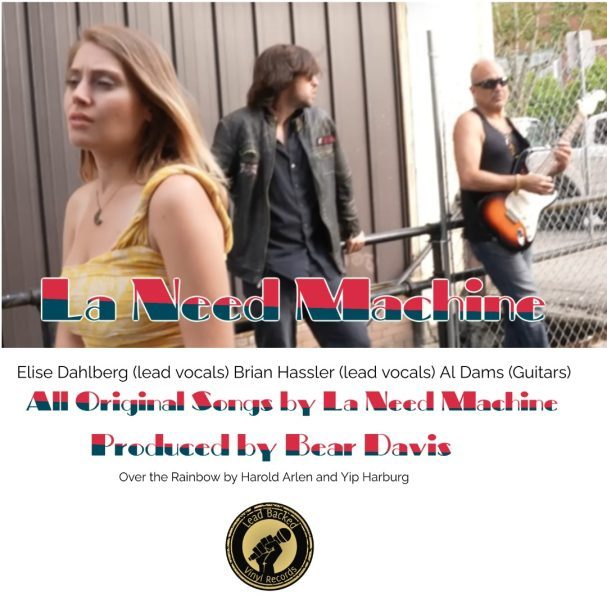From the overcast skylines and rain-washed streets of Seattle emerges La Need Machine, a band that doesn’t merely play music, but sculpts sound into stories that resonate across time, identity, and experience. This dynamic group has quietly yet boldly redefined the contours of indie rock with a musical style that’s as emotionally textured as it is rhythmically infectious. Their sonic identity is rooted in rich vocal harmonies, poetic lyricism, and a genre-defying blend of classic rock, Americana, punk, and orchestral flourishes that collectively form their unmistakable sound.
At the heart of La Need Machine is Elise Dahlberg, the band’s neurodivergent lead singer, whose powerful voice and unflinching openness about her successful life with Autism serve as both a creative compass and an emblem of authenticity. Elise’s willingness to express her journey through music places her in a rare class of artists who turn vulnerability into strength and storytelling into liberation. Alongside her are Al Dams (guitars, vocals), Brian Hassler (lead vocals), Dawn Madsen (lead vocals), Sebastian (lead vocals), and producer Bear Davis, each member contributing unique threads to the rich tapestry that is La Need Machine’s collective voice.
What makes La Need Machine remarkable is not just their instrumentation, though their use of guitar, cello, saxophone, and keyboards is undeniably captivating, but their intuitive synergy as a band. They wield harmony like a storyteller wields plot, blending male and female vocals in a way that feels both spontaneous and finely sculpted. They do not chase genre, but rather, allow emotion and message to shape their musical architecture. In a world growing more complex, La Need Machine offers clarity through music that is candid, compassionate, and composed with care.
With the release of Pourquoi? C’est L’Amour! on April 8, 2025, La Need Machine delivers their most evocative and emotionally intelligent project to date. The album title sets the tone for a collection of songs that delve deep into the human experience, exploring longing, resilience, identity, and the quiet victories of love and hope. Soaring harmonies, magnetic storytelling, and musical craftsmanship converge to create an album that both soothes the soul and rocks the heart. Pourquoi? C’est L’Amour! doesn’t just reflect the band’s growth, it amplifies it. With a deep emotional current running through each track, listeners are invited into a soundscape that feels at once cinematic and deeply personal. It’s an album that acknowledges life’s fires, literal and metaphorical, but dares to imagine what it feels like to fly above them.
Pourquoi? C’est L’Amour! Album Track List:
I Wish I Could Fly:
La Need Machine’s I Wish I Could Fly is a stirring, cinematic ballad that kicks off with delicate acoustic guitars and a soft melodic pulse that immediately immerses the listener into a reflective and emotional space. As the track unfolds, subtle layers of instrumentation, gentle cellos, resonant keys, and warm strings, begin to swirl around the core acoustic rhythm, gradually building a rich, textured sonic landscape. The vocal interplay between the male and female vocalist is magnetic: their voices blend in seamless harmony, effortlessly trading lines and supporting one another with a compelling tenderness that enhances the narrative of the song. Their delivery is heartfelt and intimate, allowing the listener to feel the pain, longing, and subtle hope behind each word. The gradual instrumental crescendo mirrors the emotional rise in the vocals, crafting a steady climb toward an anthemic release that never feels rushed or forced.
Thematically centered on the experience of a Black Bear displaced by climate-induced wildfires, I Wish I Could Fly resonates as a symbolic cry for freedom, safety, and renewal. But beyond its powerful message, what truly elevates the song is the cohesion between its vocals and instrumentation. The soft acoustic start gives way to a lush Americana-tinged arrangement, creating a wave of emotional release that sweeps the listener into the heart of the narrative. The production is crisp and spacious, allowing every violin stroke and harmonic whisper to breathe naturally. From the opening moments, the track made me feel suspended, caught between the ache of vulnerability and the beauty of resilience. It evokes the feeling of gazing out over a burning forest with a silent wish to soar above it all. The overall atmosphere is hauntingly beautiful, deeply moving, and emotionally liberating, a glowing example of how musicality and storytelling can merge into something unforgettable.
Maria:
La Need Machine’s Maria begins with a delicate yet evocative cello strumming that immediately establishes an atmosphere of heartfelt vulnerability. From the very first notes, the song exudes a sense of nostalgic warmth, inviting listeners into a deeply personal narrative. The track masterfully blends elements of Americana, classic rock, and 1970s punk, creating a genre-defying soundscape that feels both fresh and familiar. As the melody unfolds, the emotional core of the song takes shape through rich instrumentation, including subtle percussion, poignant chord progressions, and a standout brass section in the bridge that lends a Springsteen-esque flair. This musical arrangement sets the stage for a track that’s both intimate and anthemic, resonating with the raw emotions of youth and the universal longing for acceptance and love.
Vocally, Maria soars with genuine passion and expressive vocal delivery which serves as a powerful vessel for the song’s message. His performance carries both the innocence of a school crush and the weight of an anti-bullying anthem, embodying vulnerability and strength in equal measure. The synergy between the vocals and the instrumentation is seamless, they rise and fall together, each enhancing the other in a graceful emotional dance. The backup vocalists add depth and texture to the song, bringing a deep emotive feel. As the song progresses, the layers of sound grow fuller, culminating in a lush and cathartic chorus that feels like a triumphant release. The high-quality production ensures that every note, every vocal nuance, and every instrumental detail is clear and immersive, pulling the listener deeper into the story with each passing second.
The atmosphere of Maria is one of bittersweet optimism. It’s a song that acknowledges pain but offers hope, a love letter to all the Marias out there, wrapped in resilience and romanticism. Listening to it feels like watching a poignant scene from a coming-of-age film: you’re swept up in the emotional tide, caught between memory and desire. With its melodic charm, impassioned vocals, and thoughtful arrangement, Maria doesn’t just tell a story, it makes you feel it. It’s a reminder of music’s power to speak to both the personal and the universal, and it stands as one of La Need Machine’s most evocative and affecting works to date.
Vincent Van Gogh:
La Need Machine’s Vincent Van Gogh opens with a hauntingly delicate ambiance, a blend of soft keys and reflective guitar strums that immediately evokes introspection. From the very first moments, the song immerses the listener into a world tinted with melancholy, creativity, and yearning. The track feels less like a conventional song and more like a vivid emotional portrait, echoing the turbulence and beauty of its namesake. The arrangement is cinematic and emotionally rich, with a slow build that allows each instrument, from the plaintive acoustic textures to the gentle swells of strings and keys, to breathe and expand. As the song progresses, a subtle, percussive heartbeat anchors the emotions, giving form to the swirling emotional landscape painted by the instrumentation.
The vocal performance is the heart of this piece. The vocal delivery begins in a whisper, fragile and introspective, before rising with passion in the chorus, mirroring the explosive intensity and inner torment that Vincent Van Gogh himself may have felt. It’s this dynamic interplay between restraint and release that gives the song its emotional gravity. The voice isn’t just singing the lyrics, it’s feeling them, trembling with the weight of unspoken pain and misunderstood brilliance. The vocals and instrumentation are in exquisite harmony, creating a space that feels simultaneously intimate and expansive. It’s the kind of sonic landscape where you close your eyes and see brushstrokes, thick, swirling, aching with color and life.
What makes Vincent Van Gogh truly unforgettable is its atmosphere. It doesn’t just tell the story of an artist, it puts you in his shoes, in his mind, in his aching heart. The production is pristine yet organic, ensuring every note and nuance is felt, not just heard. This is music that breathes; it aches and whispers, roars and dissolves. From start to finish, it commands stillness, demanding the listener feel every note, every silence, every crescendo. It’s a soul-stirring tribute to the fragility and intensity of artistic vision, a track that leaves you pensive, moved, and somehow more human. La Need Machine has not just written a song, they’ve painted a masterpiece.

These Old Jeans:
From the very first strum, These Old Jeans by La Need Machine feels like the slow unfolding of a treasured memory, familiar, warm, and quietly profound. The track opens with an atmospheric feel that breathes intimacy, like the soft hum of morning light spilling across a room. Gradually, more layers bloom into the mix: delicate piano flourishes, mellow percussion that pulses like a heartbeat, and subtle strings that stretch and sigh beneath the surface. Each element is masterfully placed, not to draw attention to itself, but to create a spacious, lived-in ambiance where every note seems to carry emotional residue. The production is striking in its restraint, clean, polished, yet deeply human, letting the instruments breathe like old friends sitting in a circle, reminiscing in harmony.
The vocal interplay between the singers adds another layer of emotional gravity. One voice, textured and earthy, carries the ruggedness of time passed, while the other floats above like a sigh, gentle and ethereal. When these voices merge, they don’t just harmonize, they converse, echoing each other’s weariness, hope, and quiet acceptance. There’s a subtle vulnerability in how the vocals weave through the instrumentation, neither dominating nor dissolving, but balancing in a tender equilibrium. The chorus, anchored by the phrase These old jeans have seen it all, resonates like a confessional, softly defiant, deeply personal. It’s the kind of moment that wraps itself around you, not with volume or intensity, but with emotional truth.
By the time the song reaches its bridge, pared down, stripped back, and contemplative, you find yourself entirely suspended in its world. The final chorus arrives not as a climax, but as a gentle exhale, bringing closure to the journey with quiet grace. The overall vibe of These Old Jeans is soulful and reflective, radiating a sense of peace that comes from looking back without regret. It’s a track that feels handcrafted, not just in sound but in sentiment, like denim softened by years of wear, stitched together with honesty and heart. La Need Machine has created a musical keepsake, one that doesn’t just linger in the ears, but settles deeply into the soul.
Pourquoi? C’est L’Amour! is a heartfelt reflection of La Need Machine’s artistic maturity, emotional intelligence, and unwavering authenticity. Each track offers a window into human vulnerability and triumph, framed by lush instrumentation and soul-stirring vocal performances that elevate the Seattle band’s signature sound. Whether it’s the raw ache of displacement in I Wish I Could Fly, the bittersweet hope of Maria, the introspective tribute of Vincent Van Gogh, or the quiet nostalgia of These Old Jeans, the album presents a collection of deeply resonant stories that listeners can return to time and again. La Need Machine doesn’t just craft songs, they build emotional havens. For fans of genre-blending indie rock with substance, sincerity, and soaring harmonies, Pourquoi? C’est L’Amour! is a must-listen and a testament to the healing power of music.
For more information about La Need Machine, click on the icons below.



![Pankow_77c – TAXI DRIVER.EXE [Are you talking to me or to the Feed?]](https://rockermag.com/wp-content/uploads/2025/08/ac511bb3-946e-40ee-a1e0-3616723b74e4.jpeg)